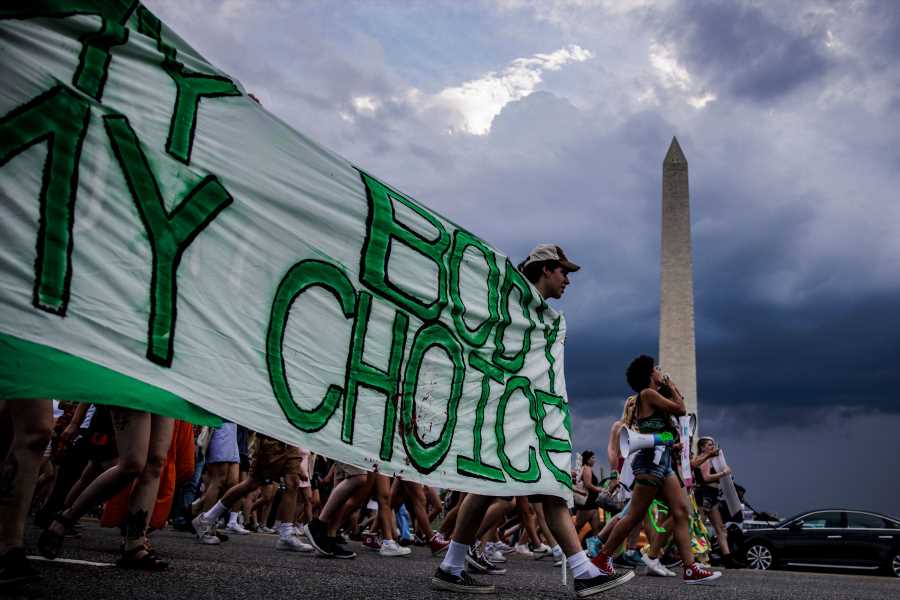
Blue States Can't Fix What the Supreme Court Broke
June 28, 2022Colorado is only one of three states that allows abortion at any phase of pregnancy. It borders five states where the fate of abortion access remains uncertain, if not outright banned. In anticipation of the reversal of Roe v. Wade, the Colorado legislature enshrined the right to abortion access in its laws back in April. “State leadership matters more than ever,” Gov. Jared Polis (D) said when the Supreme Court overturned nearly 50 years of federal abortion rights with its decision in Dobbs vs. Jackson Women’s Health on Friday. “We will not retreat to an archaic era when the powerful few controlled the freedoms over our bodies.”
But Colorado also prohibits using any state healthcare dollars from paying for abortions, meaning Medicaid recipients and state employees can’t use their coverage to access services. It also can’t adjust the state budget without a ballot referendum, complicating any efforts to set aside funding for the expected deluge of out-of-state abortion seekers on the fly.
The strain in Colorado reveals an uncomfortable truth. At a time when Republican state legislatures across the country are banning or radically restricting abortion, officials in blue states have pledged to protect access — and extend it to women whose reproductive rights are being taken. But as tens of millions of women lose access, many of those Democratic-controlled states lack the legal protections, financial resources, bureaucratic dexterity, and — in some cases — political will necessary to meet the scale of the problem. Their efforts will simply be a band-aid on a wound.
“Blue states need to do everything in their power, but we aren’t going to be able to hold the weight of the entire country” says New York representative Jessica González-Rojas, who’s led a number of abortion-related bills in the statehouse.
In many cases, ensuring abortion access will fall to people like Amanda Carlson, the director of the Cobalt Abortion Fund, a Colorado-based nonprofit that helps abortion seekers pay for both their procedures and any travel logistics. In the five hours after the Supreme Court reversed Roe, Cobalt had already received three times as many requests for assistance as it had in days before. Is there enough cash to fund each request? “For now,” Carlson says.
Cobalt had been bracing itself for “a massive influx of patients” after the Dobbs decision arrived, Carlson explains. The uptick had been building after nearby Texas and Oklahoma banned abortion in recent months. Carlson knew the work ahead would demand Cobalt finance a flood of abortion care and also serve as “a travel agency, in a way” — something Cobalt will do with a staff of only Carlson and a part-time intake coordinator. What keeps her up at night is not Cobalt’s own logistical limitations, but that of the state’s. “There are only so many appointment slots in the day for providers,” she explains.
The Supreme Court’s decision to reverse nearly 50 years of federal abortion rights on Friday unleased a wave of abortion bans across Republican-controlled states, with more expected to follow. Care now largely falls to blue states, many of which have rushed to shore up abortion rights in advance of the Dobbs decision to position themselves as abortion havens once the decision came down. “To all the women in this country, I hope you know that California has your back,” Jennifer Siebel Newsom, wife of California Gov. Gavin Newsom (D), said at a press conference on Friday.
Indeed, no state had been as prepared for this moment as California. The governor convened a Future of Abortion Council last September, which resulted in 13 bills that include legal protections for abortion seekers, millions of dollars for providers to scale up resources, and a fund for abortion seekers to cover any procedure-related logistics. All of those bills have passed or are expected to pass the assembly. But California is expected to see a 3000 percent increase in demand for abortion — and soon. “We’re being as creative as we can, but nothing would match what the federal government can do,” says Rebecca Bauer-Kahan, a member of the California state assembly who led on abortion legislation.
So far, the federal government hasn’t done much. The White House promised an “all-of-government” approach to the expected Roe reversal, but so far, the White House’s response has largely centered on encouraging voters to boost Democratic majorities in the House and Senate come November, a necessity to break the logjam on abortion rights legislation. That strategy unleashed a furious response from the left flank, which is asking the Biden administration to, among other actions, open abortion clinics on federal lands, which the adminstration says is not currently on the table. “If we’re not all pushing for the same things, [like] abolishing the filibuster and expanding the courts, then I’m not sure what we’re doing,” says Rep. Cori Bush (D-Mo.). (Vice President Kamala Harris demurred when CNN’s Dana Bash asked her Monday whether she’d support a filibuster carveout for codifying Roe.)
“We are in a state of emergency and the fact that the democrats at the federal level aren’t acting this way is completely terrifying,” González-Rojas says.
Sixteen states, mostly along the coasts, explicitly permit abortion rights in their laws. But in this landscape, adequately providing for their care requires more than just protecting rights, says Odile Schalit of the Brigid Alliance, which provides funding and logistical support for abortion seekers in New York City. It demands a sufficient number of clinics and providers “to sustain the enormous volumes of people who will need to travel,” she says. It demands funding to cover the costs of both the procedure as well as any travel logistics. The simplest abortions, done through medication early in a term, costs a few hundred dollars; later term procedures can run as high as five figures — and that’s before adding airfare, hotel, taxis, tolls, or child care costs to the bill. And it demands legal protections for not only abortion seekers, but also anyone who assists with securing or performing abortions, given laws in Texas and Oklahoma that allow private citizens to sue anyone who “aids and abets” abortions.
For now, only a handful of Democrat-controlled states have legal protections on their books against these so-called abortion “bounty hunter” laws. California, Connecticut and New York passed similar laws in recent weeks; Massachusetts Gov. Charlie Baker enacted such protections via executive order on Friday. Lawmakers who authored these bills are confident they’re defensible, but the diametric opposition to red state restrictions has set up “a really unsustainable conflict,” says Matt Blumenthal, a Connecticut state legislator who led his state’s law. The only precedent for it comes from the darkest days of the republic, when states were at “legal war with one another” over the 1850 Fugitive Slave Act, Blumenthal says.
There’s also a matter of having enough providers to do this work. Connecticut just passed a law that allows practitioners and certified nurse midwives to perform abortions, as did Washington state. New York Gov. Kathy Hochul (D) has created a discretionary fund that gives money to abortion providers to staff up. Proposals pending in California would provide $125 million to expand the number of abortion providers specifically to meet the need created by an influx of patients from anti-abortion states.
Having access to services is one thing, but being able to pay for them is something else altogether. And this where most blue states fall short. Only Oregon has allocated money to help seekers pay for abortions and any related costs, such as travel. Other states have measures pending, such as Massachusetts, which aims to set aside $2 million in a similar fund, and California, which leads the way with a pair of bills that would both help pay for abortions as well as offset the associated logistical costs. González-Rojas, the New York legislator, has a pending bill that would provide funding for logistics, but it hasn’t moved through the assembly, either.
Blue cities have been ahead of states in allocating funding for such a purpose, but that, too, has hit roadblocks. The city of Austin, Texas, provided $100,000 in funding to abortion seekers, but that fund is stuck in legal limbo, thanks to Texas’s new law. New York became the first city in the country to dedicate municipal funding to abortion care, promising $250,000 to the New York Abortion Access Fund in 2019 but, so far, none of the money has been allocated.
In the absence of public support, much of the work falls to nonprofits, like Cobalt in Colorado. Donations have been strong at peak moments of outrage, such as when the Dobbs draft leaked last month. But “this does need to sustain,” Cobalt’s Carlson emphasizes. And in a world of legal uncertainty, the Dobbs decision is also having a chilling effect on Cobalt’s peers. Carlson notes that a number of funds operating in anti-abortion states have suspended their services until they can assess the legal risk to their staff.
Upon the Dobbs decisions’ release, a pair of Colorado legislators wrote a bill offering protections against the abortion bounty-hunter laws. “We realize we’re surrounded by states who will and are actively now seeking to outlaw and criminalize abortion,” says Julie Rodriguez, a Colorado state senator who co-wrote the legislation. Gov. Polis, however, has maintained that the “ruling doesn’t change anything in Colorado,” so it won’t get a vote until January. A ballot measure blocking the use of state funds on abortion won’t get a vote until 2024.
So for now, groups like Cobalt are doing their best to absorb the work of their closed partners, backchanneling with abortion providers to find out where the soonest appointments are and mapping out how to send patients to the right clinic. “We’ve seen, for many years, people coming from other states to Colorado — that will just take on increased urgency, given the bans placed across the country,” adds Gonzales. “It’s not new work, it’s more work to be done.”
Source: Read Full Article


